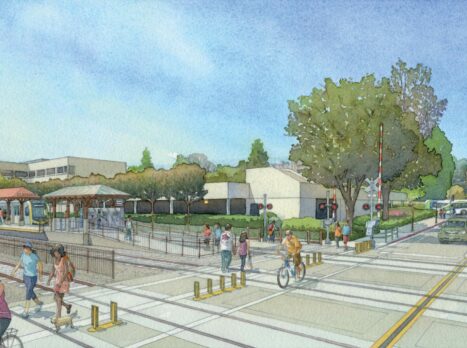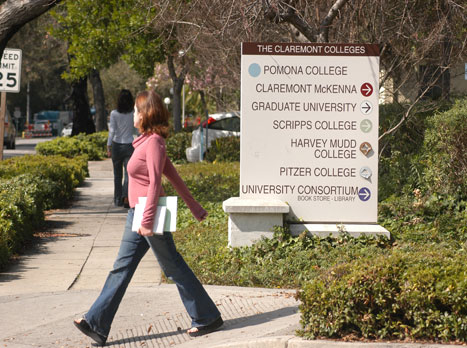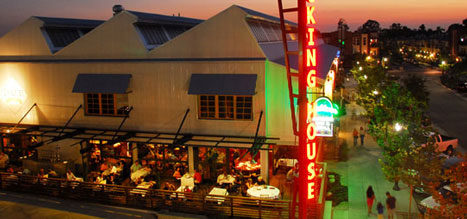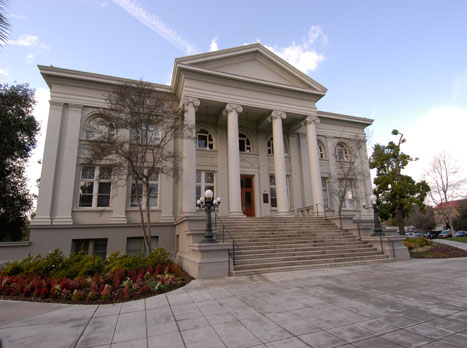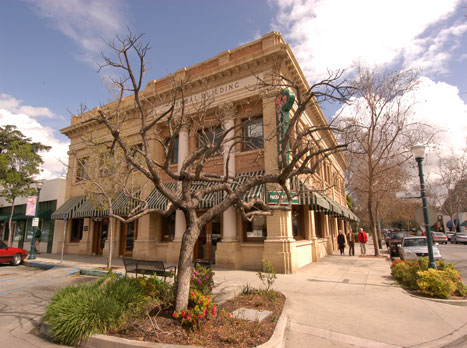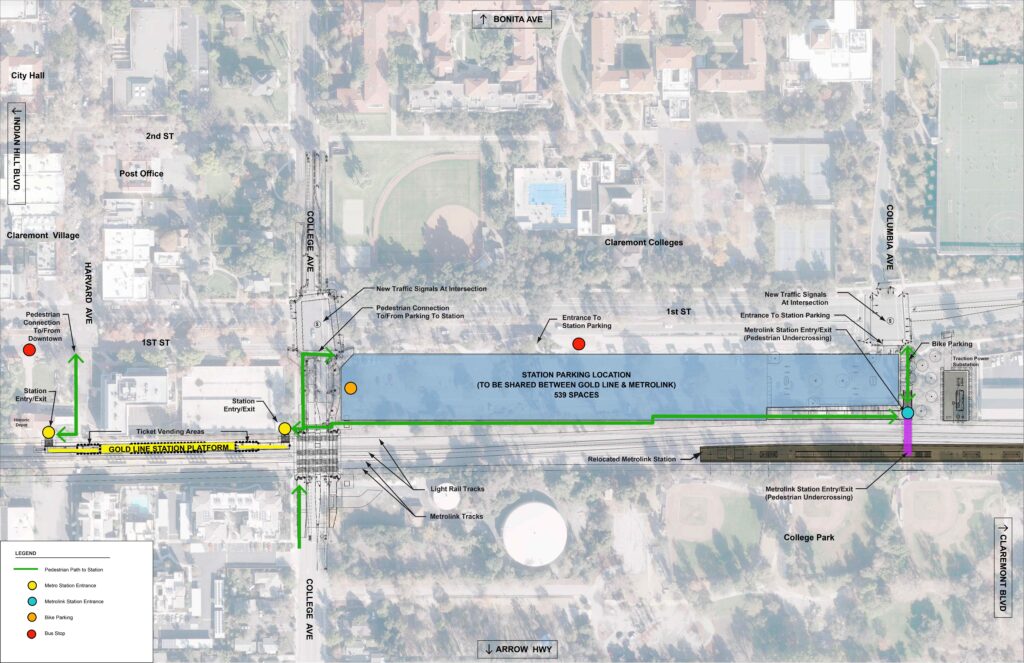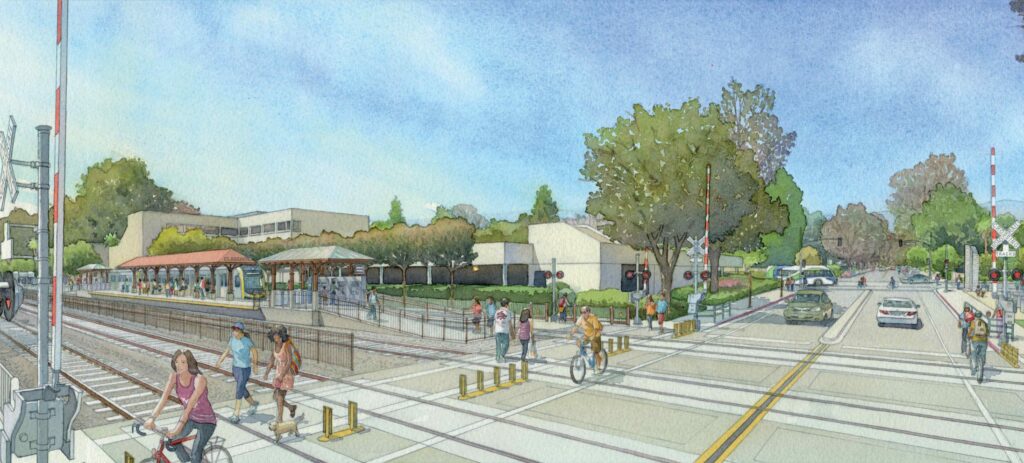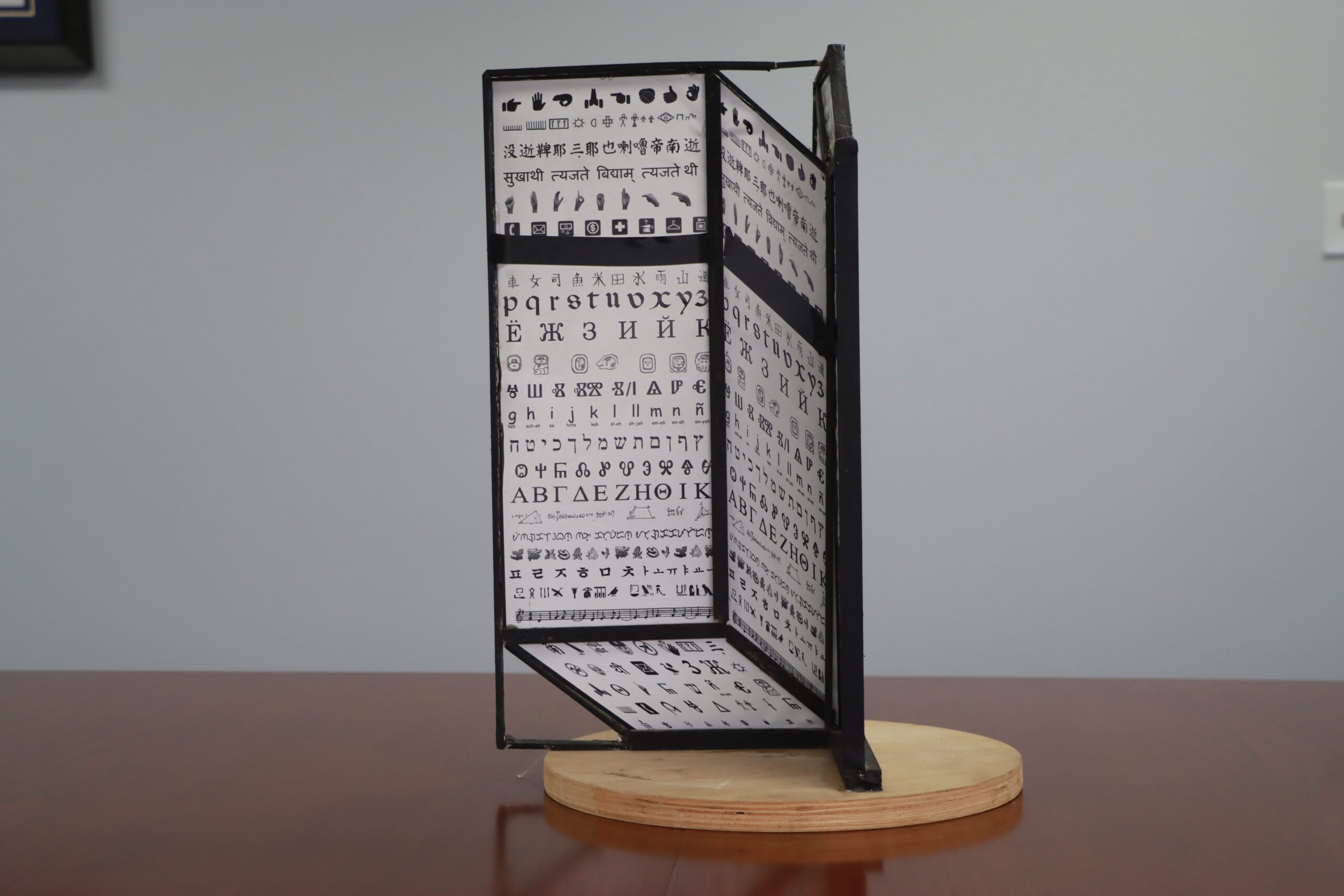renderings site plan photos
Claremont Station (Currently Unfunded)
The Claremont Station will be located approximately where the current Metrolink station is located today; east of Indian Hill and west of College Avenue. The existing Metrolink station will be relocated east of College Avenue. The A Line station will be a center platform station, with light rail tracks on either side (one for westbound and one for eastbound trains). A new 539-space parking facility for both Metrolink and A Line riders will be provided (with charging stations for EVs, bicycle parking, bus and drop off areas). Once completed, four tracks will run through the City of Claremont within one shared corridor – two light rail tracks on the north side for the A Line and two Metrolink/freight tracks on the south. While they will share the rail corridor, light rail trains and freight/Metrolink trains do not share tracks or stations.
Once funding is secured for the project segment from Pomona to Montclair (which includes the Claremont Station), and a design-builder hired, the community can expect the project to take approximately five years to build.
During construction, temporary impacts (such as short-term lane closures, extended street closures at street crossings, noise mostly from construction vehicles, and other construction-related activities) should be expected.
Permanent changes will also occur due to the project, including safety enhancements at all street crossings (raised medians, red curbing and turn restrictions within 100 feet of the rail corridor at all street crossings), relocation of the Metrolink/freight tracks to the southern half of the rail corridor, new fencing and walls along the entire rail corridor, and new overhead wires to power the more than 200 light rail trains anticipated to run daily. The Claremont Metrolink Station will be moved from its current location west of College Avenue to several hundred feet east of College Avenue. The A Line tracks will be grade-separated on a city-designed bridge over Indian Hill Boulevard, as required by the California Public Utilities Commission for safety; Metrolink and freight tracks will continue to stay at street level, including crossing Indian Hill Boulevard at street level.
Once completed, a trip from Claremont to Pasadena will take approximately 36 minutes and further to downtown Los Angeles will take approximately 65 minutes.
For more information on the station, including the public art planned, click here for the latest station fact sheet.
About the Artist
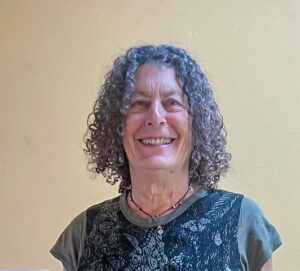
Joyce Kohl is an accomplished artist based in Altadena, California. She has experience with both public and studio/gallery art. Much of the content of her public art relates directly to the environment where it is sited. For example, in 2004, she completed a major sculpture utilizing cast iron artifacts from farming, shipping and industrial machinery for a Park & Ride in DuPont, Washington. A sculpture for the San Joaquin Valley Centennial Celebration celebrates two major industries in the area – farming and oil. Three multi sized spheres utilize round parts from those industries to create dandelion structured spheres.
Joyce initiated a tile and sculptural AIDS Wall in Harare, Zimbabwe as part of her Fulbright Fellowship. She also completed a commission on Wilshire Boulevard in Koreatown using bamboo which was cast into bronze and then welded into an unusually fluid configuration. Most recently, her involvement on this Metro project has inspired her work in glass, primarily using techniques of fusing and compression to create colorful glass work that deals with illusions of space. Her ceramics work includes clay wall works that are partially printed and stretched to play with the fine line between manmade and natural textures.
Station Art Plan
While Claremont is known for having seven university campuses – “Trees and PhD’s” – the premise for this sculpture is that the town has an incredible number of creative people “thinking outside the box.” The vast array of people (including students, professors, and other residents of all ages) utilizes an amazing diversity of symbols and languages. The structure of the sculpture includes illusionary boxes, with images of symbols depicted in layers of multi-colored glass.
The companion installation in the Metro station includes tiles located on the canopy column bases that depict places and activities that are unique to Claremont. Questions prompt the viewer on the unique destinations and the history of the area. These tiles include hand drawn and photographed images of various locations.
For more information on the artist and artwork, click here for the latest station fact sheet.
Future Plans
During 2006-7, the Construction Authority worked with the City of Claremont (along with all other Foothill Gold Line cities from Pasadena to Montclair) to explore their visions for integrating transit oriented developments (TOD) near the future station.
A premiere example of transit-oriented development along the Foothill Gold Line corridor is found in Claremont with the Claremont Village Expansion project located just west of Indian Hill Boulevard and immediately north of the current Metrolink and Foothill Gold Line right-of-way.
Within walking distance of Claremont’s historic downtown shopping and business district as well as the Metrolink (and future Foothill Gold Line) station, the project includes three core components:
Village Walk: This “new-urban design” residential neighborhood of 173 homes includes condominium lofts, town homes and duplexes, and open space areas.
The Packing House: Arteco Partners, recognized in the region for successful adaptive reuse projects and in particular for support for creative arts communities, was selected to bring new life to Claremont’s historic 1922 Citrus Packing House. The project, which officially opened in April of 2007, shines within this TOD for its detailed architectural renovation and a variety of creative storefronts and arts/entertainment venues.
The Shops and Offices, directly across the street from Village Walk and The Packing House further expands office, retail and entertainment opportunities for the City of Claremont, and includes a five-screen, 816-seat Laemmle Theater complex and Casa 425, a 28-room boutique hotel.
A 477-space parking structure supports the TOD with 6,000 square feet of retail space on Indian Hill Boulevard.
The Construction Authority and city began a new dialogue through another TOD study in 2010, which revisited the earlier concepts following the economic downturn. In 2016, the Construction Authority measured the progress of TOD implementation since the first segment of the line opened for passenger service in 2003, including reviewing the potential TOD that could take place near the stations looking forward. Click here to learn more about the TOD Studies.
First/Last Mile Plans
The first/last mile plan for the future Claremont station is overseen by Metro. Metro coordinated with the Construction Authority and City of Claremont to create a first/last mile plan for the Claremont station area. The plan was adopted by the Metro Board of Directors on June 27, 2019.
To learn more about the first/last mile plan for the future Claremont station, click here to visit Metro’s first/last mile plan website. NOTE: If you click on the link, you will be directed away from this website.
About Claremont
Located 30 miles east of downtown Los Angeles, Claremont is best known for its tree-lined streets, historic buildings, and college campuses. But more than that, Claremont is a vital balanced community that provides a wide range of programs and services for all age groups and preserves a full range of housing opportunities. It supports a variety of thriving commercial and industrial centers and protects the environment while encouraging appropriate development. In short, it respects traditional values while embracing new ideas.
Much of what Claremont is today is the direct result of actions taken by the community’s founders more than 100 years ago. Trees planted at the turn of the century now compete with nearby mountain peaks for dominance of the local skyline. The Claremont Colleges have become some of the nation’s most highly respected educational and cultural institutions. The historic central core remains a vital residential and retail district, one of the last true “downtowns” in the region. And the spirit of Claremont’s original “town meeting” form of self-governance lives on in today’s active and involved citizenry, citizens who continue to build on the successes of the past in order to ensure an even brighter future.
Learn more:
City of Claremont: http://www.ci.claremont.ca.us/
Claremont Chamber of Commerce – http://www.claremontchamber.org/
Claremont Graduate University – www.cgu.edu
Claremont Hills Wilderness Park – http://www.ci.claremont.ca.us/government/departments-divisions/human-services/parks/claremont-hills-wilderness-park-chwp
Claremont Lincoln University – https://www.claremontlincoln.edu/
Claremont McKenna College – www.cmc.edu/
Claremont Metrolink Station – https://www.metrolinktrains.com/rider-info/general-info/stations/claremont/
Claremont Museum of Art – http://claremontmuseum.org/
Claremont School of Theology – https://cst.edu/
Claremont Village – www.thevillageclaremont.com/
Claremont’s Village Expansion – http://www.thevillageclaremont.com/exp_07jan.html
Harvey Mudd College – www.hmc.edu/
Keck Graduate Institute of Applied Life Sciences – www.kgi.edu/
Pitzer College – www.pitzer.edu/
Pomona College – www.pomona.edu/
Pomona College Museum of Art – https://www.pomona.edu/museum/
Rancho Santa Ana Botanic Gardens – www.rsabg.org/
Raymond M. Alf Museum of Paleontology – www.alfmuseum.org/
Ruth Chandler Williamson Gallery – http://rcwg.scrippscollege.edu/
Scripps College – www.scrippscollege.edu/
The Packing House: www.claremontpackinghouse.com/
Discover Claremont: www.discoverclaremont.com/
